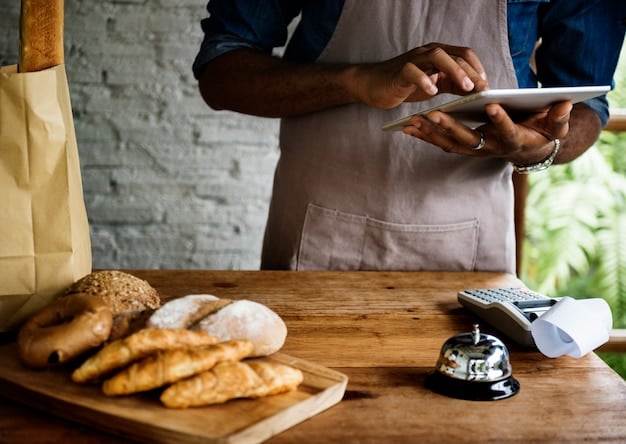Setting the right pricing for your baked goods isn’t just about math—it’s the difference between struggling to keep your home bakery open and building a thriving home baking business. Most home bakers make a critical mistake when pricing baked goods: they set retail prices based on what competitors charge or what “feels right” rather than on actual costs and profit goals. Accurate pricing is essential.
One baker I worked with, Sarah, was selling her signature sourdough loaves because “that’s what people expect to pay.” After calculating her true production costs—including ingredient costs (her primary raw materials), packaging costs, electricity, equipment maintenance, and the labor involved (her time)—we discovered each loaf’s cost of goods sold (COGS) was significant. Her small “profit” wasn’t enough to consistently cover costs like unexpected business insurance payments or provide a sustainable income. This highlights the importance of correctly pricing every item on your bakery menu.
After implementing the bakery pricing strategies in this guide, including using a simple pricing calculator, Sarah raised her selling price per loaf. She initially worried potential customers would revolt, but something surprising happened: sales remained steady, and her monthly gross profit jumped significantly. She started making good money from her home-baked goods.
The truth about pricing your baked goods is both simple and hard: customers don’t just buy based on price—they buy based on perceived value. Understanding customer perception is key. When your prices reflect the true worth of your bakery items, including specialty items, you attract more customers who appreciate quality and are willing to pay full price for it. This is a valuable service you provide.
In this guide, you’ll learn practical steps to calculate your real costs (including direct cost and indirect costs like overhead costs), set retail prices that ensure profit, and present those prices in ways that customers accept—even appreciate. We’ll break down overhead costs, labor costs (often calculated using an hourly rate), and customer psychology, and provide solutions to common pricing problems, like tricky cake pricing for a wedding cake. We’ll also touch on factors like cottage food laws relevant to home bakery pricing.
Ready to stop guessing and start pricing baked goods effectively for profit?
Our experienced drivers handle delicate baked goods with care, ensuring every cake, pastry, and loaf arrives intact
Deliver Baked Goods Safely NowLower your delivery costs by 23%
How we reduce costs:
- No delivery vehicle expenses
- Optimized local routes
- Pay-per-delivery model
- Average 23% delivery cost reduction
Step 1: How to Price Baked Goods for Profit and Establish Home Bakery Pricing
Identify all costs: ingredients, overheads, and batch expenses.
Choose a profit margin that suits your market analysis.
Match prices with perceived value to maintain profits.
Determine Your Costs Including Labor Costs
Understanding your costs is crucial. This involves calculating all the expenses involved in producing your baked goods. Start with ingredients. Make a list of everything you use, from flour to sugar. Don’t ignore small items like baking powder. Include every element that goes into each product. The goal is to have a complete picture of the ingredient costs for each item.
Next, consider overhead expenses. These are costs that aren’t directly tied to a single product but are necessary for operations. Think about utilities, rent, and equipment. Each plays a role in the cost structure. Break these down into manageable parts. Allocate a portion of these overheads to each batch, as this helps aid future pricing decisions. By having a thorough breakdown, you know precisely how much creating each batch costs.
Break Down Costs Per Batch for Bakery Items
Breaking down costs per batch simplifies the pricing process. Start by calculating the total cost for a whole batch of each product. Consider both ingredients and overheads. Divide this by the number of items in the batch. This gives you a per-item cost. Understanding this cost supports a well-informed pricing structure.
This process ensures you price each item in a way that covers all production expenses and prevents losses. You’ll feel confident knowing each item contributes to maintaining profitability.
Decide on Your Profit Margin to Set Prices
Deciding on a profit margin is essential for a successful business. This standard helps to secure a viable profit. A margin that’s too low can erode profits, while too high may deter customers.
Average Bakery Profit: The average profit margin for a bakery is approximately 4%.
Market research informs these decisions. Understand competing prices, local market trends, and consumer buying habits. Coastal areas might command higher prices compared to inland regions. A cookie can be priced differently depending on where and how you sell it.
Target Profit Margin: A fair profit margin for small bakeries ranges between 5% and 10% of revenue.
Adjusting Profit Margins
Once a baseline margin is set, adjustments are necessary. These are influenced by competition, brand perception, and economic conditions. Consider using innovative strategies to adapt prices. As Richard Branson suggests, “Creative pricing can lead to greater profitability.” Emphasizing creativity in your pricing can boost your returns. Experiment with promotional pricing, bulk discounts, or loyalty programs.
Remember, establishing a stable price structure builds trust. Indra Nooyi noted, “Understanding your market and sticking to your price is important for trust.” Regular assessment and tweaks to your margin can ensure continued success without losing customer trust.
These steps lay the groundwork for pricing success. Keep costs in check, profit margins structured, and watch your bakery thrive.
Step 2: Understanding Customer Pricing Psychology
Customer mindset affects pricing. Understanding it can help maximize profits.
Effective price presentation boosts perceived value.
Emotional cues influence buying decisions and price acceptance.
Price Presentation Tactics
Factors influencing perceived value
Price presentation isn’t just about numbers. It’s about how those numbers are displayed. Many consumers decide a product’s worth based on aesthetic cues. These can include font size, color, and even positioning on a menu or shelf. Charm pricing is one such tactic that ends prices with a 9 or .99. Removing commas from prices also makes the number feel smaller, encouraging more sales.
Effective presentation can also involve positioning prices at the top left of displays since this is where American consumers commonly begin reading. These subtle adjustments can make prices appear more favorable and influence purchasing decisions.
Examples of effective price presentation
Removing dollar signs from prices was shown to make diners spend more in upscale settings. Furthermore, smaller fonts for prices can make them feel “lower” or less intimidating. Bundle pricing is another successful tactic, encouraging larger overall purchases by offering multiple items at a discounted rate.
Emotional Triggers in Buying Decisions
Role of emotional psychology in pricing
Emotions are drivers for purchasing decisions. Fear of missing out, known as FOMO, can be a powerful motivator. Limited-time offers to tap into this by creating urgency. Trust also plays a crucial role. Customers expect personalized experiences, and many are more inclined to purchase from brands that give them personalized interactions. This empathy-based approach enhances bonds with customers. According to Seth Godin, “People don’t buy products; they buy better versions of themselves.” It’s all about how the product improves a customer’s life.
Nutritional Awareness: Ninety-two percent of selected subjects considered nutritional facts while purchasing bakery products.
Link between personal connection and price acceptance
A sense of belonging or a personal connection can justify higher prices. Personalization has shifted from being a luxury to a necessity. Consumers value loyalty programs tailored to them. Perceived value is critical. As Brian Tracy points out, it’s key to winning customer loyalty through branding and marketing.
Consumer Motivation: Special treat seekers representing 29% of fresh bakery consumers look for value and appreciate the special feel of items from the fresh bakery.
Understanding how customers think about and react to prices can help you adjust your tactics for selling baked goods. This doesn’t just lead to better sales; it builds loyal customers who feel valued.
Step 3: Calculating Overhead Costs in Baking for Your Home Bakery
Know your fixed and variable costs for accurate pricing.
Properly allocate overhead to predict product costs.
Boost profit margins through smart cost assessment.
Identify Fixed and Variable Overheads
Understand Fixed Costs
Fixed costs are expenses that do not change with the amount of goods or services produced. They remain the same regardless of business activity levels. Common fixed costs in a baking business include rent, salaries for permanent staff, and insurance. Calculating these costs accurately is essential because they represent a significant portion of your business expenses.
Startup Investment: The average cost of starting a bakery is between $10,000 and $50,000.
Recognize Variable Costs
Variable costs, on the other hand, fluctuate with production levels. In a bakery, variable costs often include ingredients, packaging, and utilities based on usage. Tracking these expenses involves carefully analyzing past bills and usage patterns. Knowing these helps you adjust your pricing according to your production volume.
Examples in a Baking Business
Fixed Costs Examples:
Rent for the bakery space
Salaries of permanent staff
Insurance premiums
Variable Costs Examples:
Flour, sugar, eggs, and other ingredients
Utility bills (water, electricity) that vary monthly
Packaging such as boxes and labels
Accurate assessment of these costs supports the entire pricing strategy and prevents underpricing your products.
Allocation of Overheads to Product Costs
Calculate Total Overheads
Start by adding up all your fixed and variable costs to get a total overhead figure. This includes every expense required to keep your bakery operating. Understanding this total is crucial for accurate cost allocation. These aggregated costs provide a complete financial picture necessary for effective pricing.
Distribute Costs per Product
To allocate overhead costs to products, divide the total overhead by the number of products you plan to produce. This method ensures each product bears a fair share of the overhead burden.
Use Real-World Examples for Clarity
Applying real-world calculations can make the process clearer. Clear calculations promote accurate pricing decisions.
Review and Adjust Periodically
Business dynamics change, and so do overhead costs. Review and adjust these allocations frequently to reflect shifts in production volumes or cost changes. Keeping this evaluation frequent ensures that prices remain accurate and profitable.
“Overhead costs are the expenses that are incurred by a business that are not directly attributed to the production of goods or services. These costs include rent, utilities, insurance, salaries of support staff, and other expenses that are necessary to keep the business running. The impact of overhead costs on your profit margins cannot be overstated.” This understanding reinforces how significant overhead management is to your baking business’s success.
Importance of Accurate Overhead Assessment
Accurate overhead assessment is vital for setting profitable prices. If overhead costs are misjudged or ignored, you risk underpricing your products, which can erode profit margins. Consistency in checking these costs translates into better financial control and sustainable business growth. A well-managed overhead strategy positions your bakery competitively in the market, ensuring long-term success and profitability.
Advanced Tips for Competitive Pricing in Bakery Business
Understand market changes to stay ahead.
Expand product lines for wider appeal.
Achieve best results with detailed plans.
Continual Market Analysis
Regular analysis of market trends is vital for staying competitive in the bakery space. Baking professionals should establish a routine for reviewing market conditions to adapt pricing policies. Watch industry reports, local market studies, and economic forecasts. These tools, when combined, help bakery owners make informed decisions to maintain competitive pricing. Keeping up with market changes can prevent pricing from slipping below cost and ensure profitability.
Global Market Value: The global bakery products market size was valued at USD 480.23 billion in 2024.
A great reference for gaining deeper insights into market analysis is “Competitive Strategy” by Michael Porter. This book explores market forces that affect pricing decisions. It provides frameworks for conducting comprehensive market analyses, which are perfect for bakery businesses looking to refine pricing strategies. However, some argue that focusing solely on market analysis could lead to neglecting other aspects, like customer expectations or unique selling points. It’s essential to balance market analysis with other factors to create well-rounded strategies. If you seek further understanding, check out industry-specific publications and local trade associations.
Projected Market Growth: The market is projected to grow from USD 504.78 billion in 2025 to USD 731.69 billion by 2032 at a CAGR of 5.45%.
Diversify Your Product Offerings
Broadening your product range can capture diverse customer preferences, supporting competitive pricing. By including seasonal or trendy items, bakeries can attract a broader customer base. For instance, offering gluten-free or vegan options caters to dietary demands. These specialty products can command premium prices, appealing to customers seeking quality or novelty.
Product Freshness: Bakery products typically have a shelf life of 2 to 3 days.
However, diversifying products can involve risks. It takes additional resources and careful planning to prevent diluting the brand’s core offerings. The key is to maintain quality across all product lines. For those interested in delving deeper into this strategy, “Blue Ocean Strategy” by W. Chan Kim and Renée Mauborgne offers valuable perspectives on creating demand in untapped markets. The book emphasizes innovative product development as a means to outpace competition. Critics may argue that too much diversification can overcomplicate operations, but if executed thoughtfully, it can prove highly advantageous. A combination of customer feedback, trend analysis, and careful planning can guide effective product diversification.
Implement Dynamic Pricing Strategies
Utilizing dynamic pricing can optimize revenue, as it allows for flexible price adjustments based on demand, competition, or other market factors. Observing price elasticity and consumer responses helps identify when and how to alter pricing. This approach is data-driven and gains insights from algorithms or specialized software to suggest sensible price changes.
Although dynamic pricing is beneficial, it requires sophisticated systems and constant monitoring. Without the correct data analysis tools, it’s easy to misinterpret trends, leading to potential consumer frustration. For bakeries considering this route, investing in platforms like Pricefx or Quicklizard can offer robust support. In terms of academic resources, “Dynamic Pricing: An Overview” by Oxford University Press examines the methodology behind this strategy and presents it as crucial for modern businesses. However, some might argue that customers dislike price fluctuation and prefer stability. The successful implementation of dynamic pricing involves clear communication and maintaining customer trust.
Focus on Customer-Centric Pricing
Customer-centric pricing builds loyalty by aligning prices with perceived value and customer satisfaction. Understanding what customers value most about your baked goods allows for tailored pricing models. Techniques such as tiered pricing, package deals, or loyalty discounts can enhance customer engagement. These incentives drive repeat business, fostering long-term customer relationships.
David Ortega points out, “Food prices tend to rise very quickly but take much longer to come down,” highlighting the pressure on pricing stability. Yet, customer-centric pricing needs balance; misjudging customer preferences or over-promising discounts could lead to reduced profits. “Priceless: The Myth of Fair Value” by William Poundstone is an insightful read for bakery owners aiming to comprehend the intricacies of customer-focused pricing. It unravels pricing psychology, equipping business owners with the knowledge to set prices that resonate with consumers while ensuring company benefits are maximized.
Monitor Competitor Retail Prices
Constantly observing competitor pricing is vital in crafting a competitive advantage. Regular competitor analysis helps understand industry standards and pinpoint unique selling propositions. By assessing competitors’ prices and reactions, bakers can adjust their pricing strategies accordingly. However, merely following competitors can lead to a price war that diminishes business value.
To exploit competitor data effectively, consider tools like Price2Spy or Kompyte for real-time competitor analysis. Additionally, “Competitive Intelligence Advantage” by Seena Sharp delves deeper into gathering and leveraging competitor insights. Some industry experts argue that an overemphasis on competitors could stifle innovation. Balancing awareness of competitive actions with a focus on unique offerings and customer experience is the key to profitable pricing.
Troubleshooting Common Issues
Double-check pricing to prevent mistakes.
Transparency is key in correcting errors.
Regular audits keep pricing accurate.
Solutions to Pricing Mistakes
Errors in pricing can eat into profits and damage reputation. Here’s how to address them effectively.
Steps to Correct Mispricing Errors
Identify the Mistake
Begin by determining what went wrong. Check if it’s a data entry error, a miscalculation, or inappropriate automatic adjustments by pricing software. Systems should log such details. This lets you trace where and why the error occurred.Double-Check Prices
Before entering prices into your systems, verify each figure. Use a checklist to ensure all components align with your pricing strategy and cost structure. Implement a policy where at least two team members review prices before finalization. Double-checking adds a safeguard against human error.Use Automated Tools
Consider implementing pricing software that flags anomalies or deviations from your set parameters. Automated alerts can notify you when prices fall outside of expected ranges. This assists in catching errors early. Investing in reliable tools can minimize manual mistakes and prevent revenue losses.Involve Your Team
Conduct regular staff training to ensure everyone understands pricing protocols. Employees should know how to spot and report potential errors. Encouraging communication about pricing issues will create a proactive environment. Open discussions about mistakes improve awareness and reduce recurrence.
Importance of Transparency in Adjustments
Acknowledge and Apologize
Upon discovering a pricing error, acknowledge it promptly. Inform customers who may have been affected. Note that mistakes happen, but the way you respond matters most. Addressing errors openly strengthens the credibility and customer relationships.Explain the Steps Taken
Outline what steps you took to correct the mistake. Whether adjustments were made manually or through software, being clear about your approach reassures customers. Highlighting your methods promotes trust and aids in future decision-making.Issue a Public Statement
Spread awareness by issuing a public statement or an email campaign if the error affected a broad audience. Detail the error, correction, and your ongoing commitment to accurate pricing. Being upfront demonstrates accountability.Provide Cost Breakdowns
Offer a breakdown of how prices are determined—materials, labor, overheads—so customers understand what they’re paying for. Transparency on cost structure builds trust. As Howard Schultz noted, “Honest pricing builds trust and long-term relationships.” Explaining costs shows accountability and fosters loyalty.Be Open About Price Changes
If adjustments involve price increases, explain their necessity. Cite economic factors like inflation or increased costs. Providing background helps customers grasp the rationale behind changes. Transparent communication avoids misunderstandings.
Regular auditing and clear communication ensure that any pricing issues are addressed swiftly and maintain the integrity of your business practices.
Further Resources and Reading
Boost business knowledge with advanced guides on bakery management.
Learn the economic impacts and long-term benefits of pricing strategies.
Explore how accurate pricing can influence business growth and customer retention.
Related topics or advanced guides
Many bakeries face pricing challenges. Expanding your knowledge is crucial to stay competitive. Business management books can provide a solid foundation. “The E-Myth Revisited” by Michael E. Gerber is highly recommended for understanding how to structure and manage small baking businesses effectively.
Online courses can also be a valuable resource. Platforms like Coursera and Udemy offer courses on bakery business management and pricing strategies. Courses include “Baking and Cake Art” and “Pricing for Profit” which delve into advanced pricing strategies and practical applications in a baking context.
Why Accurate Pricing Matters
Accurate pricing plays a huge role in a bakery’s success. It impacts everything from long-term growth to day-to-day operations. Setting the right price can be the difference between thriving and barely making it. Margins in the food industry can be tight, and mispricing can lead to lost revenue. Pricing helps ensure business sustainability in an increasingly competitive market. A well-strategized pricing structure can cushion against economic downturns or shifts in consumer demand, making it indispensable for long-term viability.
Average Bakery Revenue: The average revenue for a bakery is $400,000.
A report from the National Restaurant Association forecasts continued growth in the bakery sector for 2025. Yet, only those who adapt their pricing to reflect market realities will reap the rewards. This shows that accurate pricing is not just a financial tool but a strategic necessity.
Contextualize the Importance of the Skill or Task
Pricing directly links to customer retention and bakery growth. Consider two bakeries with the same product but different pricing strategies. The bakery with strategic pricing not only attracts new customers but retains them too. This demonstrates the importance of pricing as a growth tool. Price impacts how customers perceive the quality and value of baked goods.
Real-world examples show that pricing impacts customer loyalty. Take Starbucks, for instance. They succeed not just by selling coffee, but by pricing their offerings to reflect perceived value, which customers associate with quality and experience. With careful pricing, bakeries can achieve the same loyalty and growth in their customer base.
Accurate pricing represents more than just number-crunching—it’s a critical skill that shapes a business’s profile and future.
Frequently Asked Questions (FAQs)
What is the foundational first step to accurately price baked goods for profit?
The foundational step is meticulously calculating all your costs, including ingredients (direct costs), overhead (indirect costs like utilities, rent, equipment maintenance), packaging, and labor time (often calculated using an hourly rate).
Why is correctly allocating overhead costs essential for bakery pricing?
Accurately assessing and allocating overhead costs to each product is vital. It ensures your prices cover all business expenses, preventing underpricing which erodes profits, and supports sustainable business growth.
What’s the key takeaway for pricing complex custom orders such as a wedding cake?
Complex, high-value items, applying the core principles—meticulously calculating all costs, setting a clear profit margin, and aligning with perceived value—is even more critical due to their custom nature and higher stakes.
How do cottage food laws affect pricing strategies for home bakers?
The article mentions that cottage food laws are a relevant factor for home bakery pricing. Bakers operating under these laws need to understand how regulations regarding allowable foods, sales limits, or labeling might influence their overall cost structure, operational scope, and pricing decisions.
Conclusion
Setting the right sales price for your bakery items isn’t just about math—it’s about building a lasting business. By tracking all production costs, from raw materials like flour (food costs) to indirect costs like electricity and rent, and setting smart gross profit margins, you’ve laid the foundation for financial success. Accurate pricing ensures you cover costs and generate profit from your goods sold. You now understand how customer perception influences perceived value and how to present prices in ways that feel fair and appealing.
Overhead costs no longer need to be a mystery. You can confidently allocate these expenses across your goods sold, helping you price your baked goods appropriately while keeping prices competitive for potential customers. When challenges arise—and they will—you have troubleshooting strategies ready for setting retail prices.
The true power of proper bakery pricing extends beyond immediate profits. It creates breathing room for creativity, quality ingredients, fair wages (reflecting your hourly rate or your staff’s), and crucial equipment maintenance. It lets you weather seasonal changes and market shifts. Most importantly, it transforms baking from a stressful hobby into a sustainable home baking business where you can make good money by providing a valuable service. Equipping your home bakery with the right tools is just as important as pricing. Investing in essential baking tools can boost your efficiency and product quality, which in turn supports your pricing strategy and profitability. For those interested in upgrading or starting fresh, this comprehensive guide on vital home bakery equipment offers practical insights and recommendations. It’s a great resource for ensuring you have the tools needed to create your best baked goods and run a successful business.
Having the right baking tools is crucial for maintaining consistency and quality in your baked goods, which directly affects how customers perceive value and justify your pricing. From quality mixers to precise measuring devices, each tool plays a significant role in streamlining your baking process and reducing waste. Investing in efficient tools not only enhances productivity but also allows you to focus more on product innovation and customer satisfaction. To learn more about must-have equipment that can elevate your home bakery, explore this detailed resource on baking essentials and tools for home bakers.
Take what you’ve learned and review your current pricing for your home-baked goods this week. Even small adjustments to your selling price methodology can dramatically improve your bottom line. Your passion for baking deserves to be matched by financial reward—and now you, as home bakers, have the tools, like understanding the cost of goods sold and labor costs, to make that happen through accurate pricing. To further enhance your bakery’s sales and customer satisfaction, consider using detailed tools like a comprehensive sheet cake serving chart. This chart helps you accurately estimate servings and price your cake products effectively, which can improve customer confidence and increase order volumes. Utilizing such practical resources ties directly into your pricing strategy by aligning portion sizes, perceived value, and revenue goals.
Another practical resource that can elevate your pricing accuracy is a refined detailed sheet cake serving chart. This tool not only aids in precise serving estimations but also helps standardize pricing strategies for cakes, ensuring consistency and fairness. Bakers who implement such charts report improved customer satisfaction and increased sales by aligning product portioning with customer expectations and pricing clarity. Integrating this chart into your pricing process complements the financial strategies discussed earlier and can be a game changer in your bakery’s profitability and customer retention.














